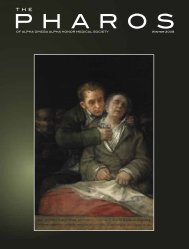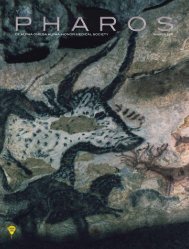4 - Alpha Omega Alpha
4 - Alpha Omega Alpha
4 - Alpha Omega Alpha
Create successful ePaper yourself
Turn your PDF publications into a flip-book with our unique Google optimized e-Paper software.
The name of Marat dishonors your race. He was a ferocious<br />
beast, who was about to devour the remains of France by<br />
the fire of civil war.<br />
—Charlotte Corday at trial 16p198<br />
As his skin condition worsened, Marat continued writing at<br />
a furious pace. He published a second journal, Junius François,<br />
in addition to numerous pamphlets. In 1792 he was elected as<br />
the people’s representative to the National Convention, the<br />
first legislative body of the newly formed Republic of France.<br />
He quickly learned that his friends were few as he addressed<br />
the Convention after his election: “ ‘In this Assembly I have a<br />
large number of Personal Enemies.’ ” The assembly cried back<br />
“ ‘All of us, all of us!’ ” 5pxxiv<br />
As his status increased, so too did his denunciations. They<br />
seemed almost random, and his most consistent position was<br />
hypervigilance. Though Marat seemed to hate any man in a<br />
position of prominence, his ire was most consistently aimed<br />
at those in the Girondin party, the ruling majority in the<br />
National Convention. They had initially enjoyed the backing<br />
of the people, but in the mood of the times, today’s radicals<br />
were tomorrow’s moderates. The Girondins had exhausted<br />
their support on a failed war against Prussia and the party’s<br />
reluctance to bring Louis XVI to trial. Inspired by Marat, the<br />
commoners of Paris had no such reservations, and their voices<br />
would not be denied—Louis was guillotined in 1793. In an effort<br />
to silence Marat, the Girondin-led Tribunal arrested him<br />
on the charge of inciting to rebellion. After his acquittal, he<br />
led the Convention to overthrow the Girondin leadership, in<br />
favor of the more radical Jacobin rule. It was a period of soaring<br />
rhetoric and rule by an iron fist, but the Jacobins held the<br />
promise of economic stability. The Girondins fled death, and<br />
many sought refuge in the northern city of Caen.<br />
Marat’s medical condition kept him confined to his baths<br />
but did not prevent him from working on a small table improvised<br />
from an upturned wooden box. On the twelfth of July,<br />
1793, the painter Jacques-Louis David visited Marat beside his<br />
tub to wish him a rapid recovery. He admired Marat, even if<br />
he did not fully understand him, and he held that the only true<br />
martyrs were revolutionary ones. Unknowingly, he was about<br />
to get his most famous subject.<br />
The next day a young woman claiming to be from Caen<br />
appeared at 30 Rue des Cordeliers and sought an audience<br />
with Marat. He refused her on two occasions but relented<br />
when she returned a few hours later, claiming to be in possession<br />
of the names of Girondin sympathizers. The woman was<br />
Charlotte Corday, a passionate admirer of the Girondin party<br />
and, though she had traveled from Caen, she had not come to<br />
betray her fellow patriots. When she began to recount to him<br />
the names of the traitors, Marat replied, “ ‘Good, in a few days<br />
I will have them all guillotined.’ ” 2p736 In an instant she leaned<br />
over the man, pulled a knife out from the top of her dress, and<br />
plunged it down hard into the Marat’s right chest. The knife<br />
By and about Jesse Woodard<br />
I am a member of the class of 2009<br />
at the University of South Carolina<br />
School of Medicine. I currently reside<br />
in Greenville, South Carolina, where I<br />
am completing my fourth and final year<br />
preparing for a career in radiology. In<br />
the few moments of my day that are not<br />
currently consumed with the residency<br />
matching process, I reminisce about how much happier<br />
I would potentially have been had I not abandoned my<br />
first love—cooking. I enjoy listening to folk music, eating<br />
fruit roll-ups in a single bite, and doing the crossword<br />
puzzle with my wife over a cup of coffee.<br />
pierced “between the first and second rib, traversing the upper<br />
part of the right lung as well as the aorta, and going into the<br />
left clavicle.” 3p258 He called for help but any aid was in vain.<br />
Corday did not attempt escape. Expecting her arrest, she<br />
carried her certificate of baptism and a letter to the nation of<br />
France explaining her actions. At trial she calmly defended<br />
her actions, “I knew he was perverting France. I killed one<br />
man to save a hundred thousand.” 16p198 Four days later she was<br />
guillotined. Immediately upon decapitation, one of the executioner’s<br />
assistants—a man hired for the day named Legros—is<br />
said to have lifted her head from the basket and slapped it on<br />
the cheek.<br />
David—a great painter with<br />
strong political views<br />
The responsibility of vengence fell to Jacques-Louis David,<br />
rightly regarded as the greatest neoclassical painter in France.<br />
A Jacobin member of the National Convention, David had<br />
voted for the death of the king, an odd career move since<br />
Louis XVI had commissioned his most famous work to date<br />
The Oath of the Horatii. The work had earned him a reputation<br />
for capturing the revolutionary spirit, and his depiction of<br />
The Death of Marat is a lesson in propaganda.<br />
David sought to portray Marat as a revolutionary martyr,<br />
painting him in a pose much like that of Christ in<br />
Michelangelo’s Pieta and Caravaggio’s Deposition of the Cross.<br />
So striking was this similarity that the work would later be<br />
known as “David’s Pieta.” The wound in Marat’s side and the<br />
linen clothes are clear references to Christ, as is the simple<br />
wooden desk which recollects the cross.<br />
Marat himself is idealized in the painting. His skin is fair.<br />
He appears peaceful, perhaps even smiling. The instrument of<br />
The Pharos/Spring 2009 21














